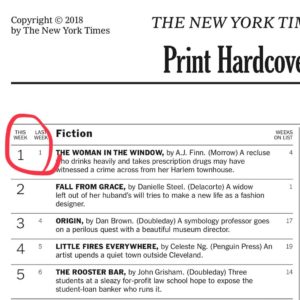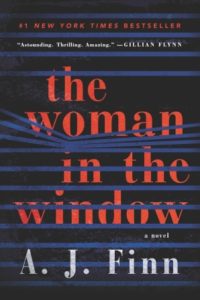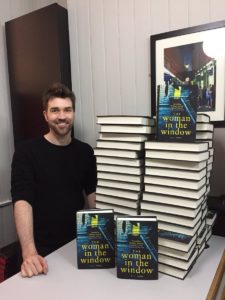 You would think that A.J. Finn would know all the rules of writing genre fiction especially psychological thrillers. Just before his first novel hit the #1 slot on the New York Times bestseller list four weeks ago, he was an executive editor at William Morrow publishing company working on the novels of authors like Karin Slaughter and Val McDermid. Yet, in The Woman In the Window ( Rear Window, the movie, meets The Girl On The Train) Finn breaks a lot of big rules.
You would think that A.J. Finn would know all the rules of writing genre fiction especially psychological thrillers. Just before his first novel hit the #1 slot on the New York Times bestseller list four weeks ago, he was an executive editor at William Morrow publishing company working on the novels of authors like Karin Slaughter and Val McDermid. Yet, in The Woman In the Window ( Rear Window, the movie, meets The Girl On The Train) Finn breaks a lot of big rules.
What He Did Wrong
Of course, rules exist to be broken –but not usually by first time authors who, as unknowns, must query agents and pitch editors at publishing houses. Finn didn’t have to do that. As an editor in the publishing industry, he has friends who are agents, and/or knows agents whom he could approach without sending a query letter. I wrote about his good fortune in that area in my blog last week.
So, it may be that given his standing in the publishing industry, he felt he had a little more leeway in ignoring the advice which agents, writing workshops, and how-to craft books try to instill in first-time authors: For example, the first ten pages sell the book; something has to happen in the first ten pages; info dumping should not slow the action, most genre fiction should stay within an 80,000 – 90,000 words; protagonists should not awake from a dream in the first chapter; (okay, okay, if you’re a struggling author/writer you know the rest.)
Long & Slow?
 The Woman In The Window, a story about a hard-drinking, pill-popping recluse who believes she has witnessed a violent crime in the house across the street, runs to 440 pages. This is approximately 30, 000 more words than is usually tolerated in this genre. More significantly, in this thriller nothing thrilling happens for 32 chapters. If you’ve read the book, you might disagree and say: But the book starts with Anna spying, and focusing her powerful Nikon camera, on the people in the house across the street, watching the wife about to seduce another man in a guest bedroom while her husband is walking up the street to their front door.
The Woman In The Window, a story about a hard-drinking, pill-popping recluse who believes she has witnessed a violent crime in the house across the street, runs to 440 pages. This is approximately 30, 000 more words than is usually tolerated in this genre. More significantly, in this thriller nothing thrilling happens for 32 chapters. If you’ve read the book, you might disagree and say: But the book starts with Anna spying, and focusing her powerful Nikon camera, on the people in the house across the street, watching the wife about to seduce another man in a guest bedroom while her husband is walking up the street to their front door.
Sure, it’s exciting stuff. But not really. The chapter is pure misdirection disguised as action. The couple in this vignette never appear in the novel again, and their actions are neither material nor relevant to the main plot or even any secondary plot.
Info-Dumping?
The novel then progresses into the second chapter where Anna talks to her husband and young daughter, apparently on the phone. The reader understands that Anna’s physical separation from her husband and child has something to do with her agoraphobia which she has suffered for ten months Oh, in case you are not inclined to google that disorder and don’t know the meaning of the word, A.J. Finn then treats the reader to some serious info dumping on the disorder, even citing to the Diagnostic and Statistical Manual of Mental Disorders. In the beginning chapters he also describes in detail, floor-by-floor the five-story Harlem townhouse (with roof garden) around which she rattles alone and drunk, and offers a short treatise on Hitchcock noir classics which she watches round the clock and from which one-liners interweave very cleverly (“seamlessly” in Stephen King’s view) with Anna’s muddled thinking.
What He Did Right
 So, what’s going on here? Where’s the thrill part of the thriller? Of course, it needs to be stated quite clearly that, as slow as the beginning was, I, like thousands of other readers, did not put this thriller aside. It took more than 10 pages to hook me, but I gave it time. Why? Because Finn, whose real name is Dan Mallory, knows what he’s doing.
So, what’s going on here? Where’s the thrill part of the thriller? Of course, it needs to be stated quite clearly that, as slow as the beginning was, I, like thousands of other readers, did not put this thriller aside. It took more than 10 pages to hook me, but I gave it time. Why? Because Finn, whose real name is Dan Mallory, knows what he’s doing.
He has (seriously) studied the craft of writing fiction and psychological suspense. He told the Houston Chronicle that he grew up reading P.D. James, Agatha Christie, Arthur Conan Doyle and Josephine Tey and Ruth Rendell. He views Henry James’s The Turn of the Screw as the original psychological thriller. He studied Patricia Highsmith and her brand of psychological suspense in a graduate program at Oxford University. He spent years working on books by J.K. Rowling, Patricia Cornwell, Val McDermid, Karin Slaughter and Sarah Paretsky. And, when he reads for pleasure, he acknowledged: “I always make time for Gillian Flynn and Kate Atkinson.”
Borrowing From The Best
He also knows enough to borrow from the biggest bestselling author of all time. He told the New York Times, that he credits James Patterson as a helpful influence, particularly when it comes to short chapters.” He has also said that “as an editor and reader, I do know that big blocks of text and long chapters can be daunting.” WITW has 100 chapters (one is just four paragraphs) and an epilogue.
He told National Public Radio (NPR) “When Gillian Flynn published Gone Girl, I thought Aha, this is the sort of book I’ve loved and could possibly try to write. The trouble was I didn’t have a story.” So, how did he find one? Hitchcock’s movie Rear Window was obviously an inspiration.
Write What You Know
 He also adhered to a rule that has been drilled into many first-time writers over decades: Write What You Know. He has mentioned his own experience with depression and agoraphobia in most of his interviews. He told NPR, “During 15 years when I struggled with misdiagnosed bipolar disorder, there were times I couldn’t prise myself from bed, let alone leave the house.” And, in an interview with the British newspaper, The Guardian, he said: “Thinking of Highsmith, and sociopathy and my own depression… all of these things coincided, and this character Anna just sort of strode into my brain lugging her story behind her.”
He also adhered to a rule that has been drilled into many first-time writers over decades: Write What You Know. He has mentioned his own experience with depression and agoraphobia in most of his interviews. He told NPR, “During 15 years when I struggled with misdiagnosed bipolar disorder, there were times I couldn’t prise myself from bed, let alone leave the house.” And, in an interview with the British newspaper, The Guardian, he said: “Thinking of Highsmith, and sociopathy and my own depression… all of these things coincided, and this character Anna just sort of strode into my brain lugging her story behind her.”
No doubt about it, the description of Anna’s daily life is so detailed and compelling, it draws the reader right in. If you’ve never rattled around a five-story townhouse too afraid to set foot outside your front door, you will know exactly what that feels like after reading WITW. Finn told the Houston Chronicle that the focus on Anna’s daily life in the first third of the book is deliberate: “I tried to spend time acclimating the reader to her daily routine… I take some time adjusting the reader to what a day as an agoraphobic person might be like.”
So Anna watches DVDs of her favorite noir movies, spends time at her computer, engages in chat with other agoraphobics online, takes online French lessons, plays online chess, spies on her neighbors with a very powerful camera , and searches for information about them on the Internet. Necessities of life come to her: her physical and mental therapists make house calls; her prescriptions and wine are delivered to the door, her handyman tenant in the basement takes her trash to the curb, and the new neighbors, a wife and mother named Jane Russell, and her teenaged son Ethan visit her. Oh, and Anna drinks a humongous amount of merlot with which she washes down a humongous amount of prescription drugs.
Must Have Plot
 Of course, there is a reason for her agoraphobia and self-medication and that reason is slowly revealed over the first half of the book. While Anna is separated from her husband and child, in their chats, they appear to have a friendly relationship. So, there is a mystery about this: what happened between Anna and her husband? Why are they separated?
Of course, there is a reason for her agoraphobia and self-medication and that reason is slowly revealed over the first half of the book. While Anna is separated from her husband and child, in their chats, they appear to have a friendly relationship. So, there is a mystery about this: what happened between Anna and her husband? Why are they separated?
My main preoccupation at first was the actual whereabouts of Anna’s husband and daughter. I surmised that they surely could not be living in an equally salubrious dwelling in Manhattan; so where are they living, I wondered? Why has this huge townhouse not become the residence of the parent who appears to have sole custody? Okay, he’s an architect, but she’s no longer making any money as a child psychologist so what kind of hovel are husband and daughter living in? That maybe distracted me more than it should have done, but was also the reason I guessed the truth of the situation long before it was revealed by Finn.
Heart Of The Story
Finn takes his time revealing how and why the separation occurred, and why Anna is so traumatized by it that she cannot leave her house.
He told NPR, “I consider it the heart of the story. It’s not about surprise. It’s about how such an event would impact someone, how they would cope with it, and how they would struggle to move past it.” Finn further explained for readers of Lindasbookbag blog: “It aims to be a suspenseful thriller that doubles as an examination of “grief, guilt and redemption.”
This may be why the pacing and plotting which readers associate with most of today’s psychological/domestic noir thrillers seems, to me, a little off in WITW. It is almost as if Finn created a great character and story, and then, as an afterthought, shoehorned them into a much tighter woman- in- jeopardy/domestic noir sub-genre.
Shortcomings?
Anna’s suspicion that someone is invading her space, creeping around the townhouse while she is in a drunken stupor comes late in the book, and when the reader learns the antagonist’s reason for doing so, it feels contrived, added almost as an afterthought because it has nothing much to do with the reason for the violent crime that Anna believes was committed in the house across the street.
Ultimately, I never felt that Anna was in real jeopardy other than falling on her face from being drunk and over-medicated — which major shortcoming also works to limit her involvement in solving the mystery. In the end, she has to learn everything from the antagonist. As Herb Scribner writes in thespectrum.com: “Those answers are delivered in such an obvious and simple way that it doesn’t pack much heat or thrill. Rather they are delivered in a cliche villain-speaks-to-the-hero style — similar to many endings in Hitchcock films.”
Action Scenes
Be that as it may, A.J. Finn knows how to write a really great action scene — perhaps from studying the great noir classics in his adolescence after his family moved to a home that was down the block from an arthouse movie theater. There are several scenes in the book which I can already imagine in the soon-to-be-made movie. Two of my favorites occur towards the end. The first has all the main characters including the cops gathered at Anna’s townhouse, and one by one they tear apart her story so that by the end of the scene she is in that “all-is-lost” situation where a protagonist is at his/her lowest point.
The second scene is the final confrontation where Anna faces her antagonist on the roof garden of her town house. Finn’s graphic narrative allows the reader to visualize every terrifying detail, making that scene alone worth the price of admission.
I have this book on my huge TBR list.
Hi Paula, obviously a lot of interest generated over this one. I’ll be curious to know what you think about it when you eventually get around to reading it.
Joanna, excellent post.
It’s been awhile since I watched Rear Window, but if my memory serves me, nothing of significance happens until well into the 2nd act.
Thanks
Ha! But Rear Window had Grace Kelly didn’t it? Seriously, I can’t say that movie was my favorite Hitchcock thriller. And, I know you’re going to ask which one is? So, here goes, it’s Marnie. I know, I know, it probably means I’m not a true Hitchcock fan????